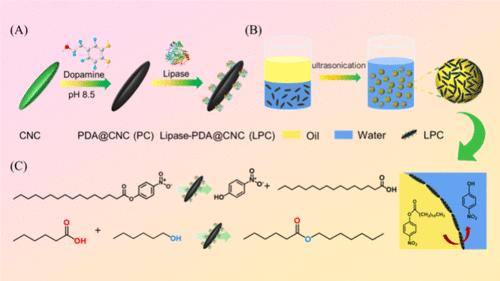用于皮克林界面生物催化的纤维素纳米晶体固定化脂肪酶
IF 7.3
1区 化学
Q1 CHEMISTRY, MULTIDISCIPLINARY
引用次数: 0
摘要
酶具有高效、条件温和、特异性强、无毒和环境友好等特点,是一种前景广阔的生物催化剂。然而,酶的稳定性和可重复使用性较差。酶固定化是提高其稳定性和可重复使用性的常用技术。本研究选择纤维素纳米晶(CNC)作为酶固定化载体,因为它具有可持续性、高比表面积、生物相容性、水分散性和出色的皮克林乳化能力。脂肪酶被固定在聚多巴胺涂层的 CNC(PC)上,与游离脂肪酶相比,得到的脂肪酶固定化 PC(LPC)在苛刻条件下的稳定性和活性显著提高。LPC 对水相和油相均具有部分润湿性,其 ZETA 电位的绝对值低于 CNC,使其具有比 CNC 更强的 Pickering 乳化能力。通过超声波将 LPC 固定在皮克林乳液的油水界面上,并将得到的皮克林乳液液滴用作微反应器,通过皮克林界面生物催化进行酯水解和合成。与传统油水双相体系中的游离脂肪酶相比,由于酶与底物的接触面积增大、底物的扩散距离缩短以及脂肪酶的界面活化效应,LPC在皮克林乳液的油水界面上显示出明显增强的催化活性。此外,LPC 可通过离心分离法方便地回收,回收后的 LPC 仍具有很高的催化活性。本研究提出了一种简便、可持续的酶固定化方法,提高了酶的稳定性和可再利用性,并通过皮克林界面生物催化显著提高了酶的活性。本文章由计算机程序翻译,如有差异,请以英文原文为准。

Cellulose Nanocrystal-Immobilized Lipase for Pickering Interface Biocatalysis
Enzymes are promising biocatalysts due to their high efficiency, mild conditions, high specificity, nontoxicity, and environmental friendliness. However, the enzyme suffers from poor stability and reusability. Enzyme immobilization is a commonly used technology to enhance its stability and reusability. In this study, the cellulose nanocrystal (CNC) was chosen as the enzyme immobilization carrier due to its sustainability, high specific surface area, biocompatibility, water dispersibility, and excellent Pickering emulsifying ability. Lipase was immobilized on a polydopamine-coated CNC (PC), and the obtained lipase-immobilized PC (LPC) displayed significantly enhanced stability and higher activity in harsh conditions compared to free lipase. LPC possessed partial wettability with both water and oil phases and a lower absolute value of the zeta potential than CNC, endowing it with a better Pickering emulsifying ability than CNC. LPC was fixed at the oil–water interface of the Pickering emulsion by ultrasonication, and the resulting Pickering emulsion droplets were employed as microreactors for ester hydrolysis and synthesis via Pickering interface biocatalysis. LPC displayed significantly enhanced catalysis activity at the oil–water interface of the Pickering emulsion compared to free lipase in a traditional oil–water biphasic system due to the increased contact area between the enzyme and the substrate, reduced diffusion distance of the substrate, and lipase interface activation effect. Moreover, LPC could be facilely recycled by centrifugation, and the recycled LPC still retains high catalysis activity. This study proposed a facile and sustainable method of enzyme immobilization to enhance its stability and reusability and achieved a significantly increased activity via Pickering interface biocatalysis.
求助全文
通过发布文献求助,成功后即可免费获取论文全文。
去求助
来源期刊

ACS Sustainable Chemistry & Engineering
CHEMISTRY, MULTIDISCIPLINARY-ENGINEERING, CHEMICAL
CiteScore
13.80
自引率
4.80%
发文量
1470
审稿时长
1.7 months
期刊介绍:
ACS Sustainable Chemistry & Engineering is a prestigious weekly peer-reviewed scientific journal published by the American Chemical Society. Dedicated to advancing the principles of green chemistry and green engineering, it covers a wide array of research topics including green chemistry, green engineering, biomass, alternative energy, and life cycle assessment.
The journal welcomes submissions in various formats, including Letters, Articles, Features, and Perspectives (Reviews), that address the challenges of sustainability in the chemical enterprise and contribute to the advancement of sustainable practices. Join us in shaping the future of sustainable chemistry and engineering.
 求助内容:
求助内容: 应助结果提醒方式:
应助结果提醒方式:


